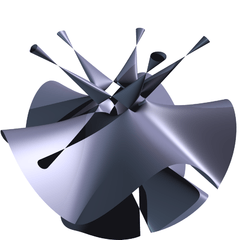Togliatti surface

The surface with w=1 (real points, bounded by a sphere with radius=6).
In algebraic geometry, a Togliatti surface is a nodal surface of degree five with 31 nodes. The first examples were constructed by Eugenio G. Togliatti (1940). Beauville (1980) proved that 31 is the maximum possible number of nodes for a surface of this degree, showing this example to be optimal.
See also
References
- Beauville, Arnaud (1980), "Sur le nombre maximum de points doubles d'une surface dans P3 (μ(5) = 31)", Journées de Géometrie Algébrique d'Angers, Juillet 1979/Algebraic Geometry, Angers, 1979 (PDF) (in French), Alphen aan den Rijn—Germantown, Md.: Sijthoff & Noordhoff, pp. 207–215, MR 0605342 .
- Togliatti, Eugenio G. (1940), "Una notevole superficie di 5o ordine con soli punti doppi isolati", Beiblatt (Festschrift Rudolf Fueter) (PDF), Vierteljschr. Naturforsch. Ges. Zürich (in Italian), 85, pp. 127–132, MR 0004492 .
External links
- Endraß, Stephan (2003). "Togliatti surfaces".
- Weisstein, Eric W. "Togliatti surface". MathWorld.
This article is issued from
Wikipedia.
The text is licensed under Creative Commons - Attribution - Sharealike.
Additional terms may apply for the media files.